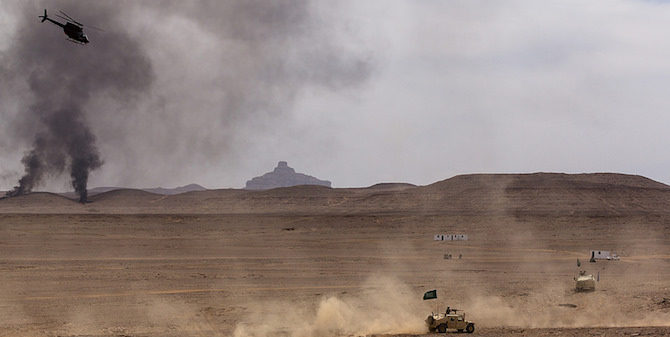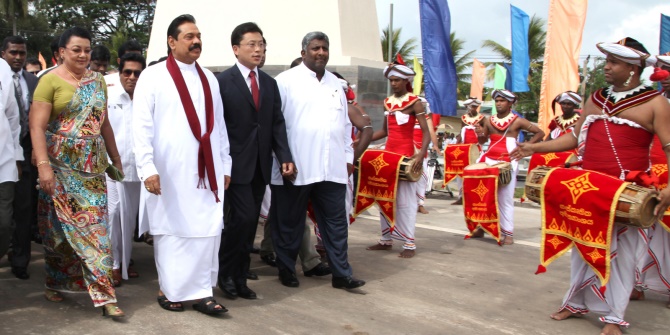 Last month, the Indian Prime Minister made his first official visit to Iran, underlining the extent to which relations between India and Iran have improved since he took office in 2014. In this article Sumit Kumar analyses some of the key agreements signed during the visit and discusses how they fit in to both India and Iran’s wider foreign policy objectives.
Last month, the Indian Prime Minister made his first official visit to Iran, underlining the extent to which relations between India and Iran have improved since he took office in 2014. In this article Sumit Kumar analyses some of the key agreements signed during the visit and discusses how they fit in to both India and Iran’s wider foreign policy objectives.
India’s policy towards West Asia has undergone a remarkable shift under the Modi government, with Iran being a major foreign policy priority. The recent visit of Prime Minister Modi to Iran on May 21-22, which resulted in the signing of 12 agreements in areas ranging trade, commerce, security, counterterrorism and others, served to highlight this fact.
During the UPA government India-Iran bilateral ties faced severe a bad weather. New Delhi voted against Tehran twice in the Security Council and lowered oil imports due to mounting pressure of the US and the economic sanctions imposed by western countries.When the Modi government came to power in New Delhi, India decided to correct its policy to Iran. The first sign of this understanding appeared when Prime Minister Modi met Iranian President Hassan Rouhani on the sidelines of the BRICS/SCO summits in Ufa, Russia on 9 July 2015. The removal of the economic sanctions, following the nuclear deal between Iran and the P5+1 (China, France, Russia, UK, USA and Germany) further freed India to cement the ties with Iran. This became visible when in a short span of time; India’s National Security Adviser Ajit Dodger, Transport Minister Nitin Gagare, Natural Gas, Petroleum Minister Dharmendra Pradhan and External Affairs Minister Sushma Swaraj visited Iran in quick succession, laying the foundation for the successful visit of the Prime Minister Modi.

One of the most important aspects of Mr Modi’s visit was his meeting with Iranian Supreme Leader Grand Ayatollah Sayyid Ali Hosseini Khamenei, because Ayatollah rarely holds such a meeting with visiting heads of state. In turn, the meeting has underscored the high importance that Iran’s government and its supreme religious leader accord to India. Another noteworthy aspect was the announcement by Mr Modi that India would invest about $500 million building the Chabahar port. This could be a strategic move by India to counter China, which is building the Gwadar port of Pakistan, just over 100 km from Chabahar port. This port will also provide India with trade routes to Afghanistan, Central Asia, and beyond.
Along with the development of the Chabahar port, the signing of the trilateral agreement of transit and transport corridor between India, Iran and Afghanistan has given a clear indication that these three countries are focused on deepening regional connectively. This will not only neutralise Pakistan’s importance as far as a transit route between India and Afghanistan, Central Asia and Europe is concerned. It is also viewed as a response to the developing of the China-Pakistan Economic Corridor. This transit and transport corridor would also pay a major role in ensuring economic development, peace and security of Afghanistan after the withdrawal of NATO forces. It will be further boosted by the India-supported International North South Transport Corridor (INSTC) project aimed at connecting the regional countries of South, Central and West Asian countries with Russia and Europe. Consequently, it would enable India to check China’s One Belt One Route project. The development of the Chabahar port will make Iran an international trade conduit for landlocked Central Asia and Afghanistan. This in turn will improve Iran’s economically backward provinces of Sistan and Baluchestan, where Chabahar is located. The strategic significance of the port will further enhance Iran’s position in this region.
Improved ties between New Delhi and Tehran are needed for meeting India’s energy requirements. With the US-led western economic sanctions on Iran being lifted, New Delhi wants secure increased access to Iranian oil and petroleum products. This in turn will also reduce India’s dependability on other oil exporting countries like Saudi Arabia. India is aiming at developing Farzad-B gas field in the Persian Gulf discovered by OVL. With these energy interests in mind, India has already made a part payment of US$ 750 million out of US$ 6.5 billion payable to Iran for crude already imported, as Iran has expressed its displeasure in the past over the issue of payments for oil imports. Deepening ties with India in the energy sector is in Iran’s interest. Given India’s growing economy, convergences of security interests between New Delhi and Tehran and tensions between Iran and European countries, Iran sees India as a vital and reliable destination for its oil exports.
India and Iran share each other’s deep concerns about the growing terrorism in the region. More importantly, without naming Pakistan, the two countries urged to put an end all support and sanctuaries enjoyed by terrorist groups and individuals and were of the view that States that aid, abet and directly or indirectly support terrorism should be condemned.
Prime Minister Modi has therefore succeeded in infusing a new momentum into the relationship between India and Iran. At the same time, India and Iran should take concrete steps to foster cooperation in the defense area and facilitate the signing of a free trade agreement so that bilateral ties can be further expanded and deepened.
Note: This article gives the views of the author, and not the position of the South Asia @ LSE blog, nor of the London School of Economics. Please read our comments policy before posting.
About the Author
 Sumit Kumar is ICSSR Doctoral Fellow at the UGC Centre for Southern Asia Studies at Pondicherry University
Sumit Kumar is ICSSR Doctoral Fellow at the UGC Centre for Southern Asia Studies at Pondicherry University







